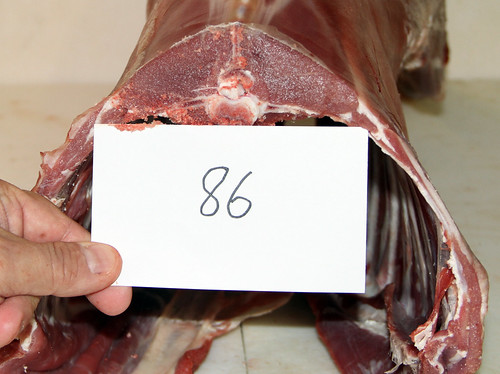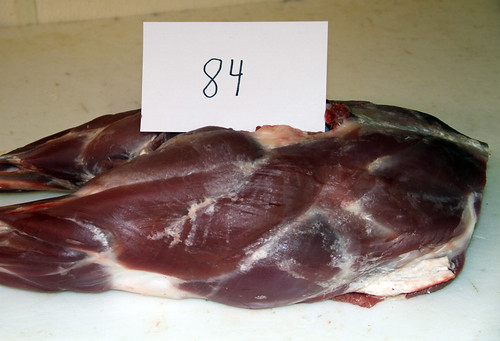Nine goats from the pasture test and nine goats from the pen were harvested on September 29 by Country Foods, a custom exempt slaughterhouse in Waynesboro, PA. The carcasses were deboned on October 5.
Carcass measurements were determined by Jeff Semler, David Gordon, Mary Beth Bennett, and Susan Schoenian. A sample of the longissimus dorsi muscle was collected from each carcass. The samples will be sent to the meat lab at The Ohio State University for analysis.
The goats in the feed pen produced superior carcasses as compared to the goats in the pasture test. While their carcasses contained more kidney and heart fat (KH) and overall fat, they were heavier muscled and yielded a higher percentage of boneless meat. According to the meat cutter, the quality of the meat from the pen-fed goats was superior (firmer) to the meat from the goats in the pasture group.
In both groups, the highest-yielding goat was the Myotonic consigned by Whitmore Farm (MD). The Myotonic from the pasture test had a boneless meat yield of 24.8 percent, whereas the Myotonic from the pen had a boneless meat yield of almost 30 percent (29.8). The Myotonic breed is known for having a superior meat-to-bone ratio. While the Myotonic carcasses were shorter, they stood out for their conformation, especially in the leg.
Another goat with a superior carcass was the biggest goat (86 lbs.) from both groups, a Spanish buck consigned by Karen Cooper (KY). This buck had a rib eye area of 2.10 square inches and a boneless meat yield of 28.8 percent. Randy and Lolli Allen (TN) had two Kiko bucks from the pen that excelled in both rib eye area and boneless meat yield. One of the Allen goats had the largest rib eye (2.15 square inches). The Cooper and Allen goats were also the higher-yielding goats in the pasture group.
Download carcass data
Download carcass comparison data
Download consigner comparison data
Carcass measurements were determined by Jeff Semler, David Gordon, Mary Beth Bennett, and Susan Schoenian. A sample of the longissimus dorsi muscle was collected from each carcass. The samples will be sent to the meat lab at The Ohio State University for analysis.
 |
| Goat with largest rib eye area (2.15 sq. in) |
The goats in the feed pen produced superior carcasses as compared to the goats in the pasture test. While their carcasses contained more kidney and heart fat (KH) and overall fat, they were heavier muscled and yielded a higher percentage of boneless meat. According to the meat cutter, the quality of the meat from the pen-fed goats was superior (firmer) to the meat from the goats in the pasture group.
In both groups, the highest-yielding goat was the Myotonic consigned by Whitmore Farm (MD). The Myotonic from the pasture test had a boneless meat yield of 24.8 percent, whereas the Myotonic from the pen had a boneless meat yield of almost 30 percent (29.8). The Myotonic breed is known for having a superior meat-to-bone ratio. While the Myotonic carcasses were shorter, they stood out for their conformation, especially in the leg.
 |
| Hindsaddle from highest-yielding goat |
Another goat with a superior carcass was the biggest goat (86 lbs.) from both groups, a Spanish buck consigned by Karen Cooper (KY). This buck had a rib eye area of 2.10 square inches and a boneless meat yield of 28.8 percent. Randy and Lolli Allen (TN) had two Kiko bucks from the pen that excelled in both rib eye area and boneless meat yield. One of the Allen goats had the largest rib eye (2.15 square inches). The Cooper and Allen goats were also the higher-yielding goats in the pasture group.
Download carcass data
Download carcass comparison data
Download consigner comparison data











